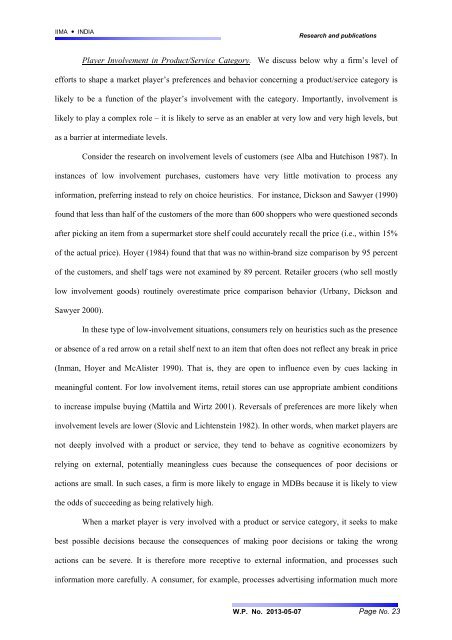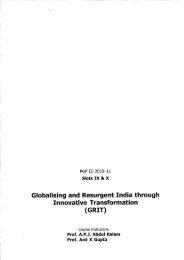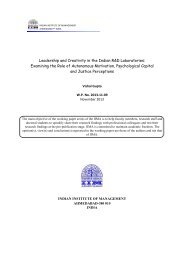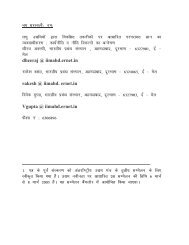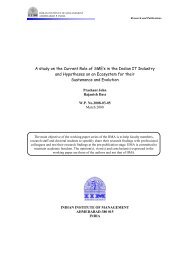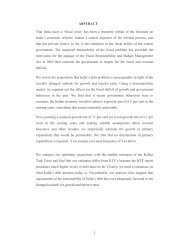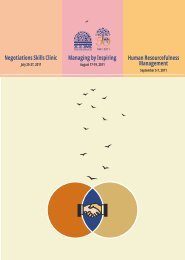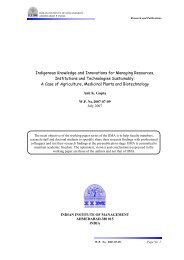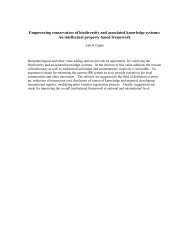to Download (English) File - Indian Institute of Management ...
to Download (English) File - Indian Institute of Management ...
to Download (English) File - Indian Institute of Management ...
You also want an ePaper? Increase the reach of your titles
YUMPU automatically turns print PDFs into web optimized ePapers that Google loves.
IIMA INDIA<br />
Research and publications<br />
Player Involvement in Product/Service Category. We discuss below why a firm’s level <strong>of</strong><br />
efforts <strong>to</strong> shape a market player’s preferences and behavior concerning a product/service category is<br />
likely <strong>to</strong> be a function <strong>of</strong> the player’s involvement with the category. Importantly, involvement is<br />
likely <strong>to</strong> play a complex role – it is likely <strong>to</strong> serve as an enabler at very low and very high levels, but<br />
as a barrier at intermediate levels.<br />
Consider the research on involvement levels <strong>of</strong> cus<strong>to</strong>mers (see Alba and Hutchison 1987). In<br />
instances <strong>of</strong> low involvement purchases, cus<strong>to</strong>mers have very little motivation <strong>to</strong> process any<br />
information, preferring instead <strong>to</strong> rely on choice heuristics. For instance, Dickson and Sawyer (1990)<br />
found that less than half <strong>of</strong> the cus<strong>to</strong>mers <strong>of</strong> the more than 600 shoppers who were questioned seconds<br />
after picking an item from a supermarket s<strong>to</strong>re shelf could accurately recall the price (i.e., within 15%<br />
<strong>of</strong> the actual price). Hoyer (1984) found that that was no within-brand size comparison by 95 percent<br />
<strong>of</strong> the cus<strong>to</strong>mers, and shelf tags were not examined by 89 percent. Retailer grocers (who sell mostly<br />
low involvement goods) routinely overestimate price comparison behavior (Urbany, Dickson and<br />
Sawyer 2000).<br />
In these type <strong>of</strong> low-involvement situations, consumers rely on heuristics such as the presence<br />
or absence <strong>of</strong> a red arrow on a retail shelf next <strong>to</strong> an item that <strong>of</strong>ten does not reflect any break in price<br />
(Inman, Hoyer and McAlister 1990). That is, they are open <strong>to</strong> influence even by cues lacking in<br />
meaningful content. For low involvement items, retail s<strong>to</strong>res can use appropriate ambient conditions<br />
<strong>to</strong> increase impulse buying (Mattila and Wirtz 2001). Reversals <strong>of</strong> preferences are more likely when<br />
involvement levels are lower (Slovic and Lichtenstein 1982). In other words, when market players are<br />
not deeply involved with a product or service, they tend <strong>to</strong> behave as cognitive economizers by<br />
relying on external, potentially meaningless cues because the consequences <strong>of</strong> poor decisions or<br />
actions are small. In such cases, a firm is more likely <strong>to</strong> engage in MDBs because it is likely <strong>to</strong> view<br />
the odds <strong>of</strong> succeeding as being relatively high.<br />
When a market player is very involved with a product or service category, it seeks <strong>to</strong> make<br />
best possible decisions because the consequences <strong>of</strong> making poor decisions or taking the wrong<br />
actions can be severe. It is therefore more receptive <strong>to</strong> external information, and processes such<br />
information more carefully. A consumer, for example, processes advertising information much more<br />
W.P. No. 2013-05-07 Page No. 23


